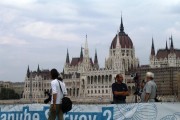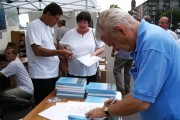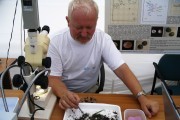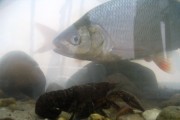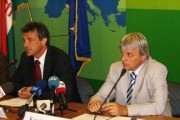
Inside the tent, Hungarian biologist Szabolcs Tyahun sits behind a microscope and a set of water samples. He works for the government water protection and inspection institute responsible for the stretch of the Danube that includes Budapest - one of ten such institutes in Hungary. "The biggest problem here is the sewage," he said. "About 50 percent of Budapest's sewage goes directly into the Danube untreated."
Europe's biggest environmental investment
A few years back, that figure was 80 percent. Treatment improved in part because of an expansion to a sewage treatment plant at the northern end of the city. By 2010, over 90 percent of Budapest's sewage will be taken care of, mainly because of a new plant being built in south Budapest. "Costing 429 million Euros, it's currently the biggest environmental investment in Europe," says Tyahun. "One of the main reasons behind building the massive plant is to fulfil the requirements of the EU's Urban Wastewater Treatment Directive - legislation that Hungary had to agree to meet if it wanted to join the EU back in 2004.
Tyahun added that microbiological pollution is another problem. "That's why swimming is prohibited around the city. But swimming is possible north of the city around towns like Szentendre and Visegrad." Tyahun also looked forward to the results coming from the JDS2. In fact, the tent by the Danube was part of an all-day public awareness raising event celebrating the arrival of the JDS2 ships to Budapest. The other main event, a press conference, was held at Hungary's environment ministry nearby - and that's where Bence Kovacs, a photographer for one of the nation's biggest daily papers, Népszabadság, was headed next, along with reporters from all of the nation's major TV stations.
Health check-up
"We want the Danube to be one of the most important rivers in Europe and the world," said Hungarian Environment Ministry State Secretary Kálmán Kovács. "This is why we want its condition to be much better than it has been." Kovács added that 95 percent of Hungary's waters come from outside its borders, "so it's important to understand the situation and that's why Hungary donated 65 million forint to the survey."
"The Danube is the most international river basin in the world," said ICPDR Executive Secretary Philip Weller. "And now we are giving it a health check-up. The JDS2 is first and foremost a scientific expedition. But secondly, it's also aimed at raising awareness about the Danube among the basin's 81 million inhabitants."
"It's been a huge work endeavour so far," said Team Leader Béla Csányi. "I haven't seen any catastrophes so far. But we know that the situation might change." Regarding the new sewage treatment plant for Budapest, Csányi said: "It's a good idea. People should clean their own waste. The river has some self-cleaning capacity, but it has its limits."
When asked about what the Danube countries had done since the first Joint Danube Survey in 2001, Weller gave examples such as the many new sewage treatment plants that had been built, and efforts to reduce pollution by the industrial and agricultural sectors. "These measures will expand as new information from the JDS2 comes in, especially given the requirements of the EU's Water Framework Directive," he said. "We hope to show where progress has been made and where there is still work to be done."
And just for that reason, the JDS2 will tomorrow sample the river south of Budapest, to see what impact the big city is having.
See Hungarian press release here.
See Associated Press/International Herald Tribune coverage of Budapest events here.













